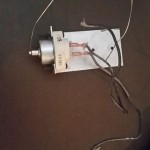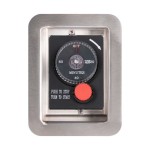Natural Gas Fireplace Heaters: A Comprehensive Guide
Natural gas fireplace heaters provide a convenient and aesthetically pleasing means of supplemental heating for homes. They offer a range of benefits, from improved energy efficiency compared to traditional wood-burning fireplaces to ease of use and consistent heat output. Understanding the different types, installation requirements, safety considerations, and maintenance procedures associated with natural gas fireplace heaters is essential for making informed decisions and ensuring their safe and efficient operation.
This article will explore the various aspects of natural gas fireplace heaters, delving into their functionality, advantages, types, installation process, safety measures, maintenance requirements, and factors to consider when choosing the right model for specific needs. The aim is to provide a comprehensive understanding of these heating appliances, enabling homeowners to make well-informed choices and enjoy the benefits they offer with confidence.
Understanding Natural Gas Fireplace Heater Functionality
Natural gas fireplace heaters operate by burning natural gas to generate heat. The gas is supplied to the fireplace through a gas line connected to the home's natural gas supply. Within the fireplace, a burner system mixes the natural gas with air, and this mixture is then ignited, creating a flame. The heat produced by the flame radiates outwards, warming the surrounding space. Many models incorporate a fan to circulate the heated air more efficiently, distributing it throughout the room. Thermostatic controls allow users to adjust the heat output to their desired level, maintaining a comfortable temperature.
The design of natural gas fireplace heaters typically includes ceramic logs or other decorative elements that mimic the appearance of a traditional wood-burning fireplace. These elements not only enhance the aesthetic appeal but also radiate heat, contributing to the overall heating efficiency. The flames are visible behind a glass screen, providing the ambiance of a traditional fireplace without the associated mess and maintenance.
Different types of ignition systems are employed in natural gas fireplace heaters. Some models use a pilot light, a small, continuously burning flame that ignites the main burner when heat is required. Others utilize electronic ignition systems, which use an electric spark to ignite the gas, eliminating the need for a standing pilot light and potentially saving energy. Electronic ignition systems are often more energy-efficient but may require a backup power source in case of a power outage.
Advantages of Natural Gas Fireplace Heaters
Natural gas fireplace heaters offer several advantages over traditional wood-burning fireplaces. One of the primary benefits is convenience. Unlike wood-burning fireplaces, natural gas models require no wood to be chopped, stacked, or carried. They can be turned on and off with the flip of a switch or the press of a button, making them easy to use and control. The consistent heat output is another significant advantage. Natural gas fireplaces provide a steady and predictable heat, unlike wood-burning fireplaces, where the heat output can fluctuate depending on the amount and type of wood being burned.
Improved energy efficiency is another key benefit. Natural gas fireplaces are generally more energy-efficient than wood-burning fireplaces, as they burn fuel more completely and do not require a chimney that can draw heat out of the home. Many models feature thermostatic controls that allow users to set and maintain a desired temperature, further optimizing energy consumption. Additionally, natural gas burns cleaner than wood, producing fewer emissions and contributing to improved air quality.
Aesthetic appeal is also a significant factor. Natural gas fireplaces are available in a wide range of styles and designs, from traditional to contemporary, allowing homeowners to choose a model that complements their home's decor. The realistic-looking ceramic logs and flickering flames create a cozy and inviting atmosphere, enhancing the ambiance of the room. Moreover, because they require no wood storage or ash removal, natural gas fireplaces are cleaner and more convenient than their wood-burning counterparts.
Types of Natural Gas Fireplace Heaters
Several types of natural gas fireplace heaters are available, each offering different features and benefits. These include direct-vent fireplaces, vent-free fireplaces, and natural gas fireplace inserts. Understanding the characteristics of each type is crucial for selecting the most suitable option for specific needs and installation conditions.
Direct-vent fireplaces are sealed units that draw combustion air from outside the home and vent exhaust gases directly outdoors through a dedicated vent pipe. This design ensures that no indoor air is used for combustion, preventing the depletion of oxygen and eliminating the risk of carbon monoxide poisoning. Direct-vent fireplaces are considered to be a safe and efficient option, and they can be installed in a variety of locations, as they do not require a traditional chimney.
Vent-free fireplaces, also known as ventless fireplaces, do not require a vent or chimney. They burn natural gas very efficiently, producing minimal exhaust gases. However, it's imperative to use a vent-free fireplace with caution, and only in spaces that are designed to allow proper ventilation. These are typically supplemental heaters intended specifically for temporary or intermittent heating, not to serve as the primary heat source. They must have proper safety features, such as oxygen depletion sensors (ODS), which automatically shut off the unit if oxygen levels drop too low.
Natural gas fireplace inserts are designed to be installed within an existing wood-burning fireplace. These inserts convert the inefficient wood-burning fireplace into a more efficient and convenient natural gas-powered heating appliance. Installation typically involves running a gas line to the fireplace and connecting it to the insert. Fireplace inserts offer a cost-effective way to upgrade an existing fireplace and improve its heating efficiency.
Installation Requirements and Considerations
The installation of a natural gas fireplace heater typically requires the services of a qualified professional, such as a licensed plumber or HVAC technician. Proper installation is essential for ensuring the safe and efficient operation of the appliance. The installation process involves several steps, including running a gas line to the fireplace, connecting the fireplace to the gas line, and venting the exhaust gases (in the case of direct-vent fireplaces). Local building codes and regulations must be followed to ensure compliance and safety.
One of the primary considerations during installation is the location of the fireplace. The fireplace should be positioned in a location that allows for adequate ventilation and clearance from combustible materials. The manufacturer's instructions should be carefully followed to ensure that the fireplace is installed according to the specified requirements. The size of the room and the heating requirements should also be considered when choosing the size and BTU output of the fireplace.
Gas line installation is a critical aspect of the process. The gas line must be sized appropriately to provide sufficient gas flow to the fireplace. The gas line should be inspected for leaks after installation to ensure that there are no gas leaks. Venting requirements vary depending on the type of fireplace being installed. Direct-vent fireplaces require a dedicated vent pipe that runs to the outside of the home. The vent pipe must be installed according to the manufacturer's specifications to ensure proper venting of exhaust gases.
Safety Measures for Natural Gas Fireplace Heaters
Safety is paramount when operating a natural gas fireplace heater. Several safety measures should be followed to prevent accidents and ensure the safe operation of the appliance. Regular maintenance, including inspection of the gas line, burner system, and venting system, is essential for identifying and addressing potential safety hazards. Carbon monoxide detectors should be installed in the home to provide early warning of carbon monoxide leaks.
It's imperative to never use flammable liquids near the fireplace. Flammable liquids can ignite and cause a fire or explosion. The area around the fireplace should be kept clear of combustible materials, such as furniture, curtains, and paper. Children and pets should be supervised when the fireplace is in operation to prevent burns or other injuries. The glass screen on the fireplace can become hot during operation, so it's important to avoid touching it.
If a gas leak is suspected, immediately turn off the gas supply to the fireplace and evacuate the premises. Do not use any electrical devices, such as light switches or telephones, as these could create a spark and ignite the gas. Contact the local gas company or fire department to report the leak and arrange for repairs. Never attempt to repair a gas leak yourself.
Maintenance Requirements for Optimal Performance
Regular maintenance is essential for ensuring the optimal performance and longevity of a natural gas fireplace heater. Maintenance tasks include cleaning the burner system, inspecting the gas line, and checking the venting system. The frequency of maintenance will depend on the type of fireplace, the frequency of use, and the manufacturer's recommendations.
Cleaning the burner system involves removing any debris or dust that may have accumulated on the burner. A soft brush or vacuum cleaner can be used to clean the burner. The pilot light (if applicable) should also be cleaned to ensure proper ignition. Inspecting the gas line involves checking for leaks or damage. A soapy water solution can be applied to the gas line connections to check for leaks. If bubbles appear, this indicates a gas leak, and the gas line should be repaired immediately.
The venting system should be inspected to ensure that it is clear of obstructions. Leaves, debris, or other materials can block the vent pipe, preventing proper venting of exhaust gases. The vent pipe should be cleaned regularly to remove any obstructions. It is best to consult a qualified technician for any maintenance or repairs that require specialized tools or expertise.
By understanding the functionality, advantages, types, installation requirements, safety measures, and maintenance procedures associated with natural gas fireplace heaters, homeowners can make informed decisions and enjoy the benefits they offer with confidence. A well-maintained and properly installed natural gas fireplace can provide a reliable and aesthetically pleasing source of supplemental heat for years to come.

Gas Fireplaces Inserts Stoves And Heaters The Hearth

Lakefield Xl Direct Vent Freestanding Gas Fireplace Stove Kozy Heat

Freestanding Gas Stoves Stove Fireplaces Napoleon

Gas Stoves Made In Usa Lopi

Fireplaces Gas Kingsman Fireplace Heater Ipi Natural Zdv3318ne

Continental
:max_bytes(150000):strip_icc()/ventless-gas-fireplaces-4160746-hero-f9d4bdcd9bd446eb84406de306f790ba.jpg?strip=all)
How To Pick Out A Ventless Gas Fireplace

Gas Fireplace Inserts Fireplacesdirect Com

Gas Fireplaces Inserts Stoves And Heaters The Hearth

Do Gas Fireplaces Heat A Room Contact The Flame Company Today
Related Posts








